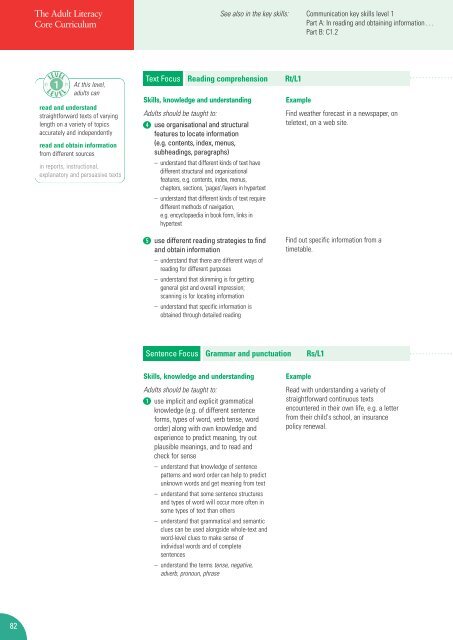Adult Literacy Core Curriculum - Nationally developed Skills for Life ...
Adult Literacy Core Curriculum - Nationally developed Skills for Life ...
Adult Literacy Core Curriculum - Nationally developed Skills for Life ...
Create successful ePaper yourself
Turn your PDF publications into a flip-book with our unique Google optimized e-Paper software.
82<br />
The <strong>Adult</strong> <strong>Literacy</strong><br />
<strong>Core</strong> <strong>Curriculum</strong><br />
At this level,<br />
adults can<br />
read and understand<br />
straight<strong>for</strong>ward texts of varying<br />
length on a variety of topics<br />
accurately and independently<br />
read and obtain in<strong>for</strong>mation<br />
from different sources<br />
in reports, instructional,<br />
explanatory and persuasive texts<br />
Text Focus Reading comprehension Rt/L1<br />
<strong>Skills</strong>, knowledge and understanding<br />
<strong>Adult</strong>s should be taught to:<br />
4 use organisational and structural<br />
features to locate in<strong>for</strong>mation<br />
(e.g. contents, index, menus,<br />
subheadings, paragraphs)<br />
– understand that different kinds of text have<br />
different structural and organisational<br />
features, e.g. contents, index, menus,<br />
chapters, sections, ‘pages'/layers in hypertext<br />
– understand that different kinds of text require<br />
different methods of navigation,<br />
e.g. encyclopaedia in book <strong>for</strong>m, links in<br />
hypertext<br />
5<br />
use different reading strategies to find<br />
and obtain in<strong>for</strong>mation<br />
– understand that there are different ways of<br />
reading <strong>for</strong> different purposes<br />
– understand that skimming is <strong>for</strong> getting<br />
general gist and overall impression;<br />
scanning is <strong>for</strong> locating in<strong>for</strong>mation<br />
– understand that specific in<strong>for</strong>mation is<br />
obtained through detailed reading<br />
<strong>Skills</strong>, knowledge and understanding<br />
<strong>Adult</strong>s should be taught to:<br />
1 use implicit and explicit grammatical<br />
knowledge (e.g. of different sentence<br />
<strong>for</strong>ms, types of word, verb tense, word<br />
order) along with own knowledge and<br />
experience to predict meaning, try out<br />
plausible meanings, and to read and<br />
check <strong>for</strong> sense<br />
– understand that knowledge of sentence<br />
patterns and word order can help to predict<br />
unknown words and get meaning from text<br />
– understand that some sentence structures<br />
and types of word will occur more often in<br />
some types of text than others<br />
– understand that grammatical and semantic<br />
clues can be used alongside whole-text and<br />
word-level clues to make sense of<br />
individual words and of complete<br />
sentences<br />
– understand the terms tense, negative,<br />
adverb, pronoun, phrase<br />
See also in the key skills: Communication key skills level 1<br />
Part A: In reading and obtaining in<strong>for</strong>mation . . .<br />
Part B: C1.2<br />
Example<br />
Sentence Focus Grammar and punctuation Rs/L1<br />
Find weather <strong>for</strong>ecast in a newspaper, on<br />
teletext, on a web site.<br />
Find out specific in<strong>for</strong>mation from a<br />
timetable.<br />
Example<br />
Read with understanding a variety of<br />
straight<strong>for</strong>ward continuous texts<br />
encountered in their own life, e.g. a letter<br />
from their child's school, an insurance<br />
policy renewal.

















